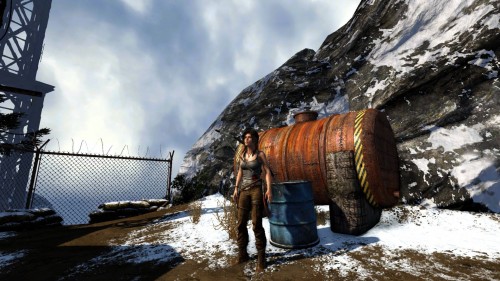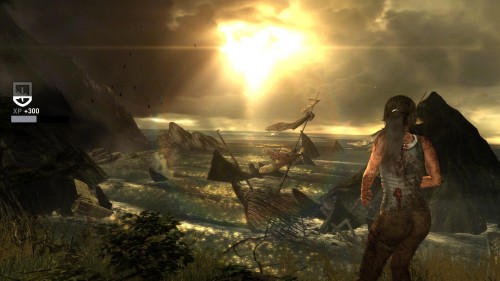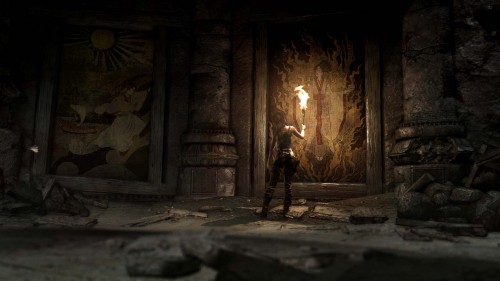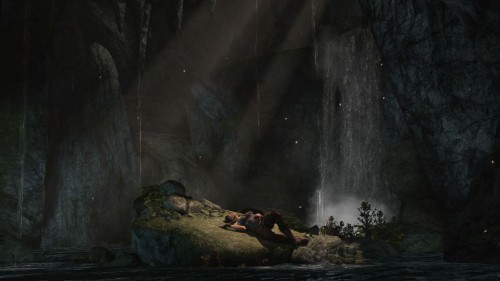In the last couple of years of the PS3 and Xbox 360, for better or worse, HD remakes were storming the gaming marketplace. It wasn’t the biggest leap of the imagination to think that the same trend would continue on in the new generation of systems, and lo and behold it has. In the current dry spell of game releases for the PS4 and Xbox One veteran publishers Square Enix have given us Tomb Raider: Definitive Edition.
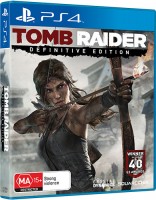 For those of you who slept through 2013: you missed a lot of cool stuff. One of the things you missed was developer Crystal Dynamics rebooting the classic action-adventure franchise Tomb Raider. Presenting the origin story of innocent British archaeologist Lara Croft, this new entry in the series set out to take back the genre from its dastardly usurper Naughty Dog’s Uncharted. It was a solid attempt, and the result was one of the better games of the year and the proverbial shot in the arm the franchise badly needed.
For those of you who slept through 2013: you missed a lot of cool stuff. One of the things you missed was developer Crystal Dynamics rebooting the classic action-adventure franchise Tomb Raider. Presenting the origin story of innocent British archaeologist Lara Croft, this new entry in the series set out to take back the genre from its dastardly usurper Naughty Dog’s Uncharted. It was a solid attempt, and the result was one of the better games of the year and the proverbial shot in the arm the franchise badly needed.
Ten months have passed since the release of the game of PS3 and 360 so of course it was time to boost the resolution, throw in some extra features, bundle up the DLC and re-release it. Given that this is a glorified port the actual game itself is no different than the original release, so therefore there isn’t much I can say about it that hasn’t already been said. The story is an adventurer-coming-of-age story following a young Lara Croft to the island of Yamatai inside the “Dragon’s Triangle” on an expedition to find the remnants of an ancient culture. What follows is a combination of excellent platforming, great voice acting (apart from some melodramatic death scenes) and a transition from innocent Lara to blood thirsty vengeful Lara, all in front of a beautiful scenic landscape. Now that that summary is out of the way I may as well move on to what is supposed to make the Definitive Edition so definitive.
First and foremost are the Definitive graphics. Crystal Dynamics have boosted the games resolution to 1080p, and it runs at a silky smooth 60 frames per second. They’ve also completely remodelled Lara Croft and have implemented TressFX which is the hair physics used in the PC version. Yes that’s right, every strand of Lara’s beautiful hair is now individually affected by physics such as wind and motion. The magnificent power of next-gen technology right? Oh, unless your character is hanging upside down in which case her hair will ignore gravity. Then of course there are the moments where the hair is bone dry and sitting perfectly immediately after coming out of water. Sure these things might ruin the immersion but look at the strands!
Despite the ridiculousness of the hair, the visual presentation of the game in general is quite impressive. It is most noticeable during the moments where the game pans out for sweeping views of things like a sprawling shantytown, a majestic mountain view, or vast cliff faces while Lara hangs from her climbing axe. These kinds of bold scenery really fit the action-adventure genre and give the game a feel very similar to movies like Indiana Jones.
The visuals aren’t the only thing to be changed in this new version of Tomb Raider though. If you’re going to bring out a game on a new console then you have to utilise the new features of the system right? The PS4 has a bag of goodies for developers to work with and Tomb Raider: Definitive Edition manages to use most of them, although not always in an effective way.
If you have a PlayStation Camera or are using a headset you can use voice commands to pause and resume the game, to bring up the map, or to change weapons. While this isn’t obviously going to suit everyone I found it to be fairly handy considering I’m fairly lazy. I appreciated not having to move my thumb off the left analog stick to swap between my weapons and when I got distracted by social media on my phone it was easy to just say “Pause”. One area where it does come in handy is bringing up the map. On the Dualshock 4 the standard control scheme is to hold down the touchpad for a second to load the map. Simply saying “Show map” worked every time and was much faster.
The touchpad can also be used to zoom and rotate when viewing relics which you pick up throughout the game, and to zoom and move on the map however I definitely found it easier and more intuitive to just use the analog sticks. Tomb Raider: Definitive Edition also utilises the light bar on the back of the DualShock 4 in a number of gimmicky and yet interesting ways. When injured the light turns red; when you have a torch lit the light flashes red and yellow simulating the glow of a flame; and when you fire a gun it flashes white. Most of these will only be noticeable if you are playing in a dark room, however they do work surprisingly well to help create an immersive atmosphere.
Another interesting use of the DualShock 4 is the speaker built into the controller. While most sounds obviously come out of your TV, whenever something close to you happens it plays through the controller speaker. If you want to take your gaming to the next level, get your PS4 controller customized. Things like the creak of the bow being drawn, or the gory squelch of Lara’s climbing axe going through an enemy’s skull also help to give a level of immersion not possible on the previous gen. There is of course also the standard feature across all games which the PS4 allows: Remote Play with the PS Vita. Using the Vita to play Tomb Raider worked perfectly for me, with the controls working quite well and even allowing the use of voice commands using the handhelds built-in microphone.
The Definitive Edition isn’t just about next-gen features though, it is also a bundle of all the DLC from the original game as well as some extras. Unfortunately from a single-player point of view there is only one added piece of gameplay content which is called “Tomb of the Lost Adventurer” which only takes around 2-3 minutes to complete. There are also some extra costumes for Lara to wear in single player but they are kind of superfluous. The majority of the DLC included falls to the multiplayer side, with things like map and weapon packs. The downside is that the multiplayer isn’t actually that good so it’s kind of pointless. I’m not saying it’s bad, but it’s nothing that hasn’t been done before.
The final additions to the Definitive Edition are the inclusion of the “Final Hours” series of videos which follow the creation of the game, and digital versions of the Dark Horse Comics tie-in prequel comic and an art book. Although these few things are nice for a quick look, they aren’t exactly driving forces to convince you to purchase the game.
That of course raises the question: is this game actually worth picking up? Well if you haven’t already played it on the previous generation then I definitely recommend getting it. The game is very good and the PS4 and Xbox One versions are clearly the best choice. If you’ve played the game before then it’s a slightly tougher question. The game is currently priced at around $80 which is kind of excessive for a port in my opinion, but if you really want to play the game again and have the cash to throw around then sure why not?
Tomb Raider: Definitive Edition is clearly the best version of the game, and arguably one of the best titles currently available on PS4 and Xbox One. While I appreciate the chance to be able to play upgraded PS3 titles on my PS4, I hope the pricing of this one doesn’t set the tone for future ports.






